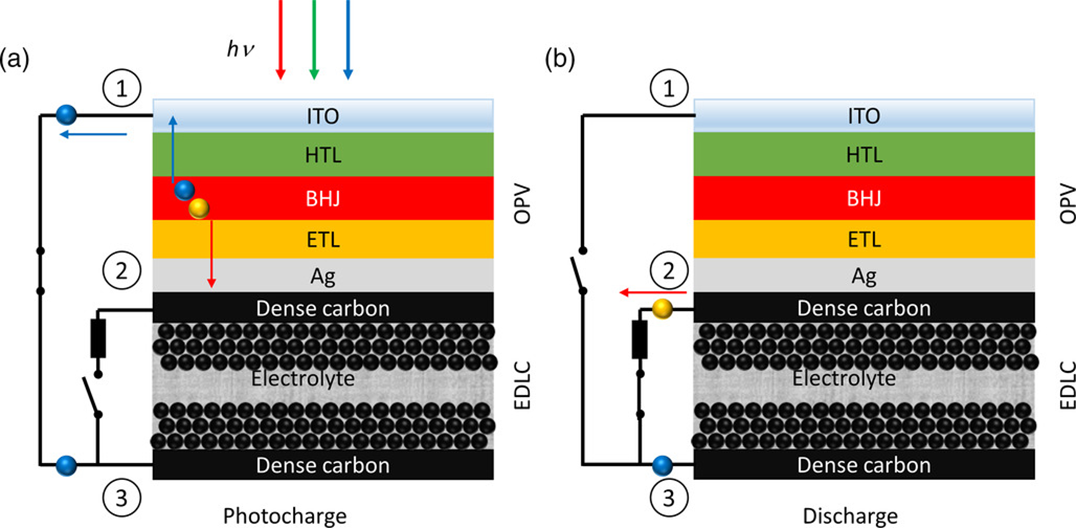News & Press
Assessing Photosupercapacitors More Precisely
Research team presents new approach that better captures the efficiency of various processes of photoconversion-storage systems during illuminating and dark phases

Schematic representation of the photosupercapacitor in a three-eletrode design during charge and discharge. Source: Rodrigo Delgado/Taisiia Berestok
Interconnected smart devices and sensors – also known as the Internet of Things – are increasingly finding their way into industry and homes. With the trend towards such miniaturized devices, there is a growing need for reliable, off-grid energy sources that also have a lower environmental impact than conventional batteries. This need could be met by photosupercapacitors, which harvest, convert, store and release solar energy on demand in a single, compact system.
Researchers at the University of Freiburg have now developed a photosupercapacitor consisting of an organic solar cell and a double-layer capacitor using a three electrodes design instead of commercially available four electrode interconnection scheme. In their case study, they also present a new approach to evaluate more precisely the efficiency of the individual processes, that take place in such a photosupercapacitor, during the illumination and dark phases. This approach takes into account the energy released by the storage unit as well as potential losses. It can be applied to other types of energy systems that convert and store solar energy. The team led by Dr. Uli Würfel, Prof. Dr. Anna Fischer, Rodrigo Delgado and Dr.Taisiia Berestok from the livMatS cluster of excellence has published its results in the journal Solar RRL.
New Type of Electrode Material
The research team's photosupercapacitor requires only three electrodes, since the solar cell and supercapacitor share one electrode. Photosupercapacitors of this design are particularly space-saving and are characterized by better overall energy and power density. The supercapacitor used is also based on a new type of electrode material, so-called nitrogen-doped carbon nanospheres (MPNC). They are porous and thus have a very large specific surface area and hence contact area at the interface of the electrolyte and the electrode where the light-generated charge carriers transferred from the solar cell are stored particularly well.
More Precise Analysis Shows Total Efficiency of Two Percent
Based on previous calculation methods, the efficiency of the photosupercapacitor is 17.4 percent. This is higher than the efficiency of previous photosupercapacitors. According to the new method, which takes potential losses into account and thus enables a more precise analysis, the total efficiency from photoconversion, storage and re-emission is 2 percent.
Original publication:
Delgado Andrés, R., Berestok, T., Shchyrba, K., Fischer, A. and Würfel, U. (2022), A New Figure of Merit for Solar Charging Systems: Case Study for Monolithically Integrated Photosupercapacitors Composed of a Large-Area Organic Solar Cell and a Carbon Double-Layer Capacitor. Sol. RRL 2200614. DOI: 10.1002/solr.202200614
Contact:
Dr. Uli Würfel
Cluster of Excellence Living, Adaptive and Energy-autonomous Materials Systems (livMatS)
University of Freiburg
Fraunhofer ISE
Tel.: 0761/203-4796
Sonja Seidel
Science Communication
Cluster of Excellence Living, Adaptive and Energy-autonomous Materials Systems (livMatS)
University of Freiburg
Email: sonja.seidel@livmats.uni-freiburg.de
Tel.: 0761/203-95361
